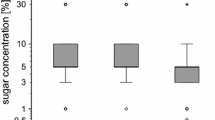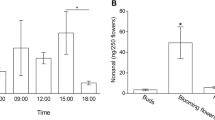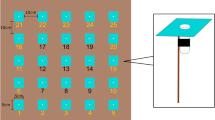Abstract
Honeybees (Apis mellifera) use odors to identify and discriminate among flowers during foraging. This series of experiments examined the ability of bees to detect and discriminate among the floral odors of different varieties of two species of canola (Brassica rapa and Brassica napus) and also among three varieties of snapdragons (Antirhinnum majus). Individual worker honeybees were trained using a proboscis extension assay. The ability of bees to distinguish a floral odor from an air stimulus during training increased as the number of flowers used during training increased. Bees conditioned to the odor of one variety of flower were asked to discriminate it from the odors of other flowers in two different training assays. Bees were unable to discriminate among flowers at the level of variety in a randomized presentation of a reinforced floral odor and an unreinforced floral odor. In the second type of assay, bees were trained with one floral variety for 40 trials without reinforcement and then tested with the same variety or with other varieties and species. If a bee had been trained with a variety of canola, it was unable to differentiate the odor of one canola flower from the odor of other canola flowers, but it could differentiate canola from the odor of a snapdragon flower. Bees trained with the odor of snapdragon flowers readily differentiated the odor of one variety of a snapdragon from the odor of other varieties of snapdragons and also canola flowers. Our study suggests that both intensity and odor quality affect the ability of honeybees to differentiate among floral perfumes.
Similar content being viewed by others
REFERENCES
Agelopoulos, N. G., and Pickett, J. A.1998. Headspace analysis in chemical ecology: Effects of different sampling methods on ratios of volatile compounds present in headspace samples. J. Chem. Ecol.24:1161–1172.
Ayasse, M., Schiestl, F. P., Paulus, H. F., Lofstedt, C., Hansson, B., Ibarra, F., and Francke, W.2000. Evolution of reproductive strategies in the sexually deceptive orchid Ophrys sphegodes: How does flower specific variation of odor signals influence reproductive success? Evolution54:1995–2006.
Beker, R., Dafni, A., Eisikowitch, D., and Ravid, U.1989.Volatiles of two chemotypes of Majorana syriacaL. (Labiatae) as olfactory cues for the honeybee. Oecologia79:446–451.
Bhagavan, S., and Smith, B. H.1996. Olfactory conditioning in the honeybee, Apis mellifera: The effects of odor intensity. Physiol. Behav.61:107–117.
Bitterman, M. E., Menzel, R., Fietz, A., and Schafer, S.1983. Classical-conditioning of proboscis extension in honeybees. J. Comp. Psychol97:107–119.
Blight, M., Le Metayer, M., Pham-Delegue, M. H., Pickett, J. A., Marion-Poll, F., and Wadhams, L. J.1997. Identification of floral volatiles involved in recognition of oilseed rape flowers, Brassica napusby honeybees, Apis mellifera. J. Chem. Ecol.23:1715–1727.
Butcher, R. D., MacFarlane-Smith, W., Robertson, G. W., and Griffiths, D. W.1994. The identification of potential aeroallergen/irritants from oilseed rape (Brassica napusspp. oleifera): volatile organic compounds emitted during flowering progression. Clin. Exp. Allergy24:1105–1114.
Chandra, S. B. C., and Smith, B. H.1998. An analysis of synthetic odor processing of odor mixtures in the honeybee, (Apis mellifera). J. Exp. Biol.201:3113–3121.
Chandra, S. B. C., Hosler, J., and Smith, B. H.2000. Heritable variation for latent inhibition and its correlation with reversal learning in honeybees (Apis mellifera). J. Comp. Psychol114: 86–97.
Chittka, L., Thomson, J. D., and Waser, N. M.1999. Flower constancy, insect psychology, and plant evolution. Naturwissenchaften86:361–377.
Dobson, H. E.M.1994. Floral volatiles in insect biology, pp. 47–81, inE. A. Bernays (ed.). Insect-Plant Interactions. CRC Press, Boca Raton, Florida.
Dobson, H. E. M., Bergstrom, J., and Bergstrom, G.1987. Pollen and flower volatiles in two Rosaspecies. Phytochemistry 26:3171–3173.
Dobson, H. E. M., Arroyo, J., Bergstrom, G., and Groth, I.1997. Interspecific variation in floral fragrances within the genus Narcissus(Amaryllidaceae). Biochem. Syst. Ecol.25: 685–706.
Dudai, N., Werker, E., Putievsky, E., Ravid, U., Palevitch, D., and Halevy, A.H.1988. Glandular hairs and essential oils in the leaves and flowers of Majorana syriaca. Isr. J. Bot.37:11–18.
Dudareva, N., and Pichersky, E.2000. Biochemical and molecular genetic aspects of floral scents. Plant Physiol. 122:627–633.
Dudareva, N., Murfitt, L. M., Mann, C. J., Gorenstein, N., Kolosova, N., Kish, C. M., Bonham, C., and Wood, K.2000. Developmental regulation of methyl benzoate biosynthesis and emission in snapdragon flowers. Plant Cell12:949–961.
Faegri K., and Van der Pijl, L.1979. The Principles of Pollination Ecology, Third ed. Pergamom Press, Oxford.
Free, J. B.1963. The flower constancy of honeybees. J. Anim. Ecol.32:119–132.
Gerber, B., Geberzahn, N., Hellstern, F., Klein, J., Kowalsky, O., Wustenberg, D., and Menzel, R.1996. Honeybees transfer olfactory memories established during flower visits to a proboscis extension paradigm in the laboratory. Anim. Behav.52:1079–1085.
Henning, J. A., Peng, Y., Montague, M. A., and Teuber, L. R.1992. Honey bee (Hymenoptera: Apidae) behavioral responses to primary alfalfa (Rosales: Fabaceae) floral volatiles. J. Econ. Entomol.85:233–239.
Jakobsen, H. B., and Olsen, C. E.1994. Influence of climatic factors on emission of flower volatiles in situ. Planta192:365–371.
Jakobsen, H. B., Friis, P., Neilsen, J. K., and Olsen, C. E.1994. Emission of volatiles from flowers and leaves of Brassica napusin situ. Phytochemistry37:695–699.
Kim, H., Kim, K., Kim, N., and Lee, D.2000. Determination of floral fragrances of Rosa hybridausing solid-phase trapping–solvent extraction and gas chromatography–mass spectrometry. J. Chromatogr. A902:389–404.
Kolosova, N., Sherman, D., Karlson, D., and Dudareva, N.2001. Cellular and subcellular localization of S-adenosyl-L-methionine:benzoic acid carboxyl methyltransferase, the enzyme responsible for biosynthesis of the volatile ester methylbenzoate in snapdragon flowers. Plant Physiol.125:1–9.
Le MÉtayer, M., Marion-Poll, F., Sandoz, J. C., Pham-Delegue, M. H., Blight, M. M., Wadhams, L. J., Masson, C., and Woodcock, C.M.1997. Effect of conditioning on discrimination of oilseed rape volatiles by the honeybee: Use of a combined gas chromatography–proboscis extension behavioral assay. Chem. Sens.22:391–398.
Matile, P., and Altenburger, R.1988. Rhythms of fragrance emission in flowers. Planta174:242–247.
McEwan, M., and Smith, W. H.1998. Identification of volatile organic compounds emitted in the field by oilseed rape (Brassica napusspp. oleifera) over the growing season. Clin. Exp. Allergy28:332–338.
Menzel, R.1990. Learning, memory and cognition in honey bees, pp. 237–292, inR. P. Kesner and D. S. Olton (eds.). Neurobiology of Comparative Cognition. Lawrence Erlbaum Assoc., Hillsdale, New Jersey.
Metcalf, R. L.1987. Plant volatiles as insect attractants. CRC Crit. Rev. Plant Sci.5:251–301.
Murfitt, L. M., Kolosova, N., Mann, C. J., and Dudareva, N.2000. Purification and characterization of S-adenosyl-L-methionine:benzoic acid carboxyl methyltransferase, the enzyme responsible for biosynthesis of the volatile ester methyl benzoate in flowers of Antirhinnum majus. Arch. Biochem. Biophys.382:145–151.
Nam, K. H., Dudareva, N., and Pichersky, E.1999. Characterization of benzylalcohol acetyltransferases in scented and non-scented Clarkiaspecies. Plant Cell Physiol.40:916–923.
Odell, E., Raguso, R. A., and Jones, K. N.1999. Bumblebee foraging responses to variation in floral scent and color in snapdragons (Antirrhinnum: Scrophulariaceae). Am. Midl. Nat.142: 237–265.
Olesen, J. M., and Knudsen, J. T.1994. Scent profiles of flower colour morphs of Corydalis cava(Fumariaceae) in relation to foraging behaviour of bumblebee queens (Bombus terrestris). Biochem. Syst. Ecol.22:231–237.
Omura, H. K., Honda, K., and Hayashi, N.1999. Chemical and chromatic bases for preferential visiting by the cabbage butterfly, Pieris rapae, to rape flowers. J. Chem. Ecol.25:1895–1906.
Pellmyr, O., and Thien, L. B.1986. Insect reproduction and floral fragrances—keys to the evolution of the angiosperms. Taxon35:76–85.
Pelz, C., Gerber, B., and Menzel, R.1997. Odorant intensity as a determinant for olfactory conditioning in the honeybee: Roles in discrimination, overshadowing, and memory consolidation. J. Exp. Biol.200:837–847.
Pham-Delegue, M. H., Masson, C., Etievant, P., and Azar, M.1986. Selective olfactory choices of the honeybee among sunflower aromas: A study by cominined olfactory conditioning and chemical analysis. J. Chem Ecol.12:781–793.
Pham-Delegue, M. H., Etievant, P., Guichard, E., and Masson, C.1989. Sunflower volatiles involved in honeybee discrimination among genotypes and flowering stages. J. Chem. Ecol.15:329–343.
Pham-Delegue, M. H., Bailez, O., Blight, M. M., Masson, C., Picard-Nizou, A. L., and Wadhams, L. J.1993. Behavioral discrimination of oilseed rape volatiles by the honeybee Apis melliferaL. Chem. Sens.18:483–494.
Pham-Delegue, M. H., Blight, M. M., Kerguelen, V., Le MÉtayer, M., Mario-Poll, F., Sandoz, J. C., and Wadhams, L. J.1997. Discrimination of oilseed rape volatiles by the honeybee: Combined chemical and biological approaches. Entomol. Exp. Appl.83:87–92.
Raguso, R. A., and Pellmyr, O.1998. Dynamic headspace analysis of floral volatiles: A comparison of methods. Oikos81:238–254.
Robertson, G. W., Griffiths, D. W., MacFarlane Smith, W., and Butcher, R. D.1993. The application of thermal desorption-gas chromatography-mass spectrometry to the analyses of flower volatiles from five varieties of oilseed rape (Brassica napusspp. oleifera). Phytochem. Anal.4:152–157.
Schiestl, F. P., Ayasse, M., Paulus, H. F., Erdmann, D., and Francke, W.1997. Variation of floral scent emission and postpollination changes in individual flowers of Ophrys sphegodessubsp. sphegodes. J. Chem. Ecol.23:2281–2289.
Smith, B. H.1998. An analysis of interaction in binary odorant mixtures. Physiol. Behav.65: 397–407.
Smith, B. H., Abramson, C. I., and Tobin, T. R.1991. Conditional withholding of proboscis extension in honeybees (Apis mellifera) during discriminative punishment. J. Comp. Psychol.105:345–356.
Sokal, R., and Rohlf, F. J.1995. Biometry. W. H. Freeman and Co., New York.
Tollsten, L., and Bergstrom, G.1988. Headspace volatiles of whole plants and macerated plant parts of Brassicaand Sinapis. Phytochemistry27:4013–4018.
Tollsten, L., and Bergstrom, G.1989. Variation and post-pollination changes in floral odours released by Platanthera bifolia(Orchidaceae). Nord. J. Bot.9:359–362.
Wadhams, L. J., Blight, M. M., Kerguelen, V., Le MÉtayer, M., Marion-Poll, F., Masson, C., Pham-Delegue, M. H., and Woodcock, C.M.1994. Discrimination of oilseed rape volatiles by honey bees: Novel combined gas chromatograph-electrophysiological behavioral assay. J. Chem. Ecol.20:3221–3231.
Waller, G. D., Loper, G. M., and Berdel, R. L.1974. Olfactory discrimination by honeybees of terpenes identified from volatiles of alfalfa flowers. J. Apic. Res.13:191–197.
Author information
Authors and Affiliations
Corresponding author
Rights and permissions
About this article
Cite this article
Wright, G.A., Skinner, B.D. & Smith, B.H. Ability of Honeybee, Apis mellifera, to Detect and Discriminate Odors of Varieties of Canola (Brassica rapa and Brassica napus) and Snapdragon Flowers (Antirrhinum majus). J Chem Ecol 28, 721–740 (2002). https://doi.org/10.1023/A:1015232608858
Issue Date:
DOI: https://doi.org/10.1023/A:1015232608858




